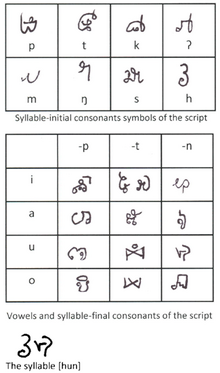Khom script (Ong Kommadam)
There are two scripts in Southeast Asia called Khom script. This article describes the obscure script from Laos that Sidwell (2008) and Jacq (2001) have described under the name "Khom script".

This Khom script is unique in the way it divides syllables. It has one set of symbols to represent initial consonants. Then it uses another set of symbols to represent the final vowel and consonant. That is, unlike a syllabary (which has unitary symbols for consonants followed by vowels (CV), with maybe a vowelless consonant following), Khom script divides the syllable as C-VC, rather than CV-C (Sidwell 2008). This is unique, not readily accommodated in any of the existing typologies of scripts.
The script was invented by Ong Kommadam, a leader in the rebellion against the French colonizers. He began using the script as early as 1924, but its use did not continue after his death in 1936. Ong Kommadam claimed supernatural titles, including “King of the Khom”, “God of the Khom”, “Sky God of the Khom” (Sidwell 2008:17). The script was linked to his divine claims, messages written in this script carried mystical power as well as meaning.
The script was revealed to outsiders by old, dying insiders on two separate occasions (Sidwell 2008). Some of the symbols resemble those from nearby scripts, but many are original.
The term "Khom" is also used to refer to the Ancient Khmer lettering used in Thailand's Buddhist temples to inscribe sacred Buddhist mantras and prayers, but that is an entirely different script.
References
- Jacq, Pascale. 2001. Description of Jruq (Loven): a Mon-Khmer language of the Lao PDR. Unpublished MA thesis, Australian National University. (Script described in appendix II, pp. 521–525)
- Sidwell, Paul. 2008. The Khom script of the Kommodam Rebellion. International Journal of the Sociology of Language 192.
